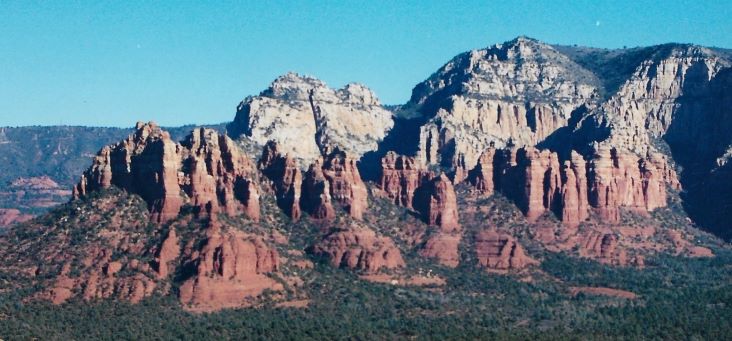This well-preserved cliff dwelling in Arizona has nothing to do with the Aztec emperor, nor was it a castle.
Earliest Settlers

The Native American Sinagua people lived in central Arizona’s Verde Valley starting around 500 CE. The Sinagua were hunter gatherers, eating local game like antelope and bear as well as smaller creatures like rabbits and turtles. They also ate indigenous fruits like wild grapes and nuts like acorns and pine nuts. Corn was an important staple, as well.
For their first centuries in the Verde Valley, the Sinagua lived in pit houses and wooden structures. Then, about 1,000 years ago, the Sunset Crater Volcano erupted and the Sinagua left the area for nearby higher ground.
When they returned, they found a that the eruption had left behind a nutrient-rich soil which made their crops more fruitful.
Montezuma Castle origin story
Upon their return, the Sinagua also realized that the Verde Valley basin was prone to flooding from the nearby Verde River and her tributaries. So, they build their dwellings in the face of the cliff, high above ground level.
These structures, ultimately reaching 5 stories and containing 20 rooms, were likely used as apartment-style dwellings for the Sinagua people. Tall ladders were used to access the village 150 feet above the ground. This not only kept the people safe from the flooding river, but also from unfriendly nearby tribes.
Construction of carved out cliff homes took place over decades, maybe even hundreds of years, starting as early as 1050 CE and peaking 300 years later. Montezuma Castle only housed about 50 people, but subsequent discoveries on the site have revealed what was an even larger dwelling, although that building has not survived. Who knows, perhaps there are other Sinagua structures yet to be discovered.
Abandonment of Montezuma Castle
The Sinagua left Montezuma Castle and the Verde Valley around 1425. Archeologists don’t know why they left for certain, but other Native Tribes left this greater region around the same time. Theories for the abandonment include drought, resource depletion, and the arrival of the Yavapai people.
Several Hopi tribes trace their ancestry to the Sinagua and have identified several cultural and linguistic similarities. Hopi members often return to the Verde Valley for religious reasons.
European Discovery
When Europeans stumbled upon the abandoned Sinagua village in the 1860’s, they dubbed it Montezuma Castle. But, the settlement had been abandoned about 40 years before the great Aztec emperor was born. And, of course, the Aztec Empire never came close to occupying the Verde Valley.
Nonetheless, the name Montezuma Castle stuck.
After this, Montezuma Castle was looted.
In 1906, the site was declared a U.S. National Monument. In 1966, it was added to the National Register of Historic Places.
Visiting Montezuma Castle
Montezuma Castle itself has been closed to visitors since 1951. The fragile state of the site could easily be destroyed by the half million annual visitors. And, being on a cliff wall, it’s not exactly safe for tourists either.
But, there is a visitor center run by the national park service. Inside is a small museum with artifacts from the site like tools used by the Sinagua.
From the visitor center it is a short walk on a paved trail to Montezuma Castle (about 1/3 mile).
Driving is definitely the easiest way to get to the site. Montezuma Castle National Monument is about 90 minutes north of Phoenix and an hour south of Flagstaff. If you’re visiting both Phoenix and Flagstaff, its an easy side trip.

If you’re staying in Sedona, you can be at Montezuma Castle is just 30 minutes by car. Jerome, another cool little Arizona town, is 40 minutes away.
If you don’t have a car, it’s a little tricky. You can take the Greyhound from Phoenix to Camp Verde (about 2 hours) and then Uber the 10 minute drive the rest of the way. From Flagstaff, take the bus south to Camp Verde (about 1 hour) and, again, Uber to the sight. There’s no bus from Jerome or Sedona.
About the Author

Brent Petersen is the Editor-in-Chief of Destination Eat Drink. He currently resides in Setubal, Portugal. Brent has written the novel “Truffle Hunt” (Eckhartz Press) and the short story collection “That Bird.” He’s also written dozens of foodie travel guides to cities around the world on Destination Eat Drink, including in-depth eating and drinking guides to Lisbon, Porto, Sintra, Monsaraz, and Evora in Portugal. Brent’s podcast, also called Destination Eat Drink, is available on all major podcasting platforms and is distributed by the Radio Misfits Podcast Network.
